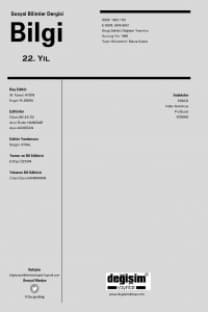İhracat Çeşitliliği ve Ekonomik Büyümenin Karbon Emisyonu Üzerindeki Etkileri: BRICS Ülkeleri Üzerine Bir Çalışma
Son dönemlerde çevre kirliliğinin artması ile birlikte çevresel sorunlar araştırmacıların ve uygulayıcıların ilgi odağı olmaya başlamıştır. Bununla birlikte çalışmanın amacı ihracat çeşitliliği, ekonomik büyüme ve CO2 emisyonu ilişkisini ortaya koymaktır. Bu amaç ile 2002- 2014 dönemi içerisinde BRICS ( Brezilya, Rusya, Hindistan, Çin ve Güney Afrika ) ülkeleri panel veri analizi ile test edilmiştir. Ampirik bulgulara göre, ihracat çeşitliliği, ekonomik büyüme ve CO2 emisyonunu pozitif yönde etkilemektedir.
EFFECTS of EXPORT DIVERSITY and ECONOMIC GROWTH on CARBON DIOXIDE EMİSSİON: A STUDY on BRICS COUNTRIES
In recent years, environmental problems have started to be the center of researchers and practitioners attention with the increase of environmental pollution. The study aims to reveal the relationship between CO2 emission and export diversity and economic growth. For this purpose, BRICS (Brazil, Russia, India, China, South Africa) countries were tested with panel data analysis in the period 2002-2014. According to empirical findings, export diversity and economic growth positively affect CO2 emissions.
Keywords:
co2 emissions, export diversification economic growth,
___
- Adewuyi, O. Adeolu, Awodumi,B. Olabanji (2016), “Analysis of the Environmental Pollution Effect of Nigeria’s Export Diversification Drive”, Annual Conference of the Nigerian Economic Society, Holding in Abuja, Nigeria from August 15 to 18, 1-26.
- Ali, Ridwan, Alwang, Jeffrey, Siegel, B. Paul (1991), “Is Export Diversification the Best Way to Achieve Export Growth and Stability?: A Look at Three African Countries”, World Bank Publications.
- Artan, Seyfettin, Hayaloğlu, Pınar, Seyhan, Burak (2015), “Türkiye’de Çevre Kirliliği, Dışa Açıklık ve Ekonomik Büyüme İlişkisi”, Yönetim ve Ekonomi Araştırmaları Dergisi, 13:308-325.
- Berthelemy, J.Claude ve Chauvin, Sophie (2000), “Structural changes in Asia and growth prospects after the Crisis”, CEPII Working Papers, 00-09.
- Breusch, Trevor S. ve Pagan, Adrian (1980), “The Lagrange Multiplier Test and its Applications to Model Specification in Econometrics”, The Review of Economic Studies, 47:239-253.
- Can, Muhlis ve Gözgör, Giray (2017), “The Impact of Economic Complexity on Carbon Emissions: Evidence from France”, Environmental Science and Pollution Research, 24:16364-16370.
- Chen, J. Hui ve Huang, Y. Fen (2013), “The Study of the Relationship between Carbon Dioxide (CO2) Emission and Economic Growth”, Journal of International and Global Economic Studies, 6:45-61.
- Condoo, Dipankor ve Dinda Soumyananda (2006), “Causality between Income and Emission: A Country Group-Specific Econometric Analysis”, Ecological Economics, 40:351-367.
- Çetintaş, Hakan, Bicil, İ. Murat, Türköz, Kumru (2016), “Türkiye’de CO2 Salınımları Enerji Tüketimi ve Ekonomik Büyüme İlişkisi”, Finans Politik&Ekonomik Yorumlar, 53:57-67.
- Fang, Jianchun, Gözgör, Giray, Lu, Zhou, Wu, Wanshan (2019), “Effects of the Export Product Quality on Carbon Dioxide Emissions: Evidence from Developing Economies”, Environmental Science and Pollution Research , 26:12181-12193.
- Herzer, Dierk, Nowak-Lehnmann, D. Fecilitas (2006), “What Does Export Diversification Do for Growth? An Econometric Analysis”, Applied Economics, 38:1825-1838.
- Intergovernmental Panel on Clımate Change (2007), “Climate Change 2007: The Physical Science Basis”, IPCC WGI Fourth Assessment Report.
- Karamelikli, Hüseyin ve Kesgingöz , Hayrettin (2015), “Dış Ticaret-Enerji Tüketimi ve Ekonomik Büyümenin CO2 Emisyonu Üzerine Etkisi”, Kastamonu Üniversitesi İktisadi ve İdari Bilimler Fakültesi Dergisi, 9:7-17.
- Manga, Müge (2019), “Orta Gelir Tuzağı Bağlamında İhracatta Ürün Çeşitlilği ile Ekonomik Büyüme Arasındaki İlişkinin İncelenmesi” Çankırı Karatekin Üniversitesi İktisadi ve İdari Bilimler Fakültesi Dergisi, 9:145-168.
- Mania, Elodie (2019), “Export Diversification and CO2 Emissions: An Augmented Environmental Kuznets Curve”, Journal of International Development, (Eylül 2019), 3:168-185.
- Norman, S. Catherine ve Deacon, T. Robert (2006), “Does the Environmental Kuznets Curve Describe How Individual Countries Behave?”, Land Economics, 291-315.
- Samen, Salomon (2010), “Export Development, Diversification and Competitiveness: How Some Developing Countries Got it Right”, World Bank Institute.
- Shahbaz Muhammad, Gözgör, Giray, Hammoudeh, Shawkat (2019), “Human Capital and Export Diversification as New Determinants of Energy Demand in the United States”, Energy Economics, 78:335-349.
- Pao, H. Tien ve Tsai, C. Ming (2010), “CO2 Emissions, Energy Consumption and Economic Growth in BRIC Countries”, Energy Policy, 38:7850-7860.
- Pesaran, M. Hashem (2007), “A Simple Panel Unit Root Test in the Presence of Ccross-Section Dependence. Journal of Applied Econometrics, 22:265-312.
- Pesaran, M. Hashem (2006), “Estimation and Inference in Large Heterogeneous Panels with a Multifactor Error Structure”, Econometrica, 74:967-1012.
- Pesaran, M. Hashem (2004), “General Diagnostic Tests for Cross Section Dependence in Panels” CESifo Working Paper Series No. 1229; IZA Discussion Paper No. 1240.
- Pesaran, M. Hashem ve Smith, Ron (1995), “Estimating Long-Run Relationships from Dynamic Heterogeneous Panels”, Journal of econometrics, 68:79-113.
- Pesaran, M. Hashem ve Yamagata, Takashi (2008), “Testing Slope Homogeneity in Large Panels”, Journal of Econometrics, 142:50-93.
- Swamy P. Aananta (1970), “Efficient inference in a Random Coefficient Regression Model”, Econometrica: Journal of the Econometric Society, 311-323.
- Tatoğlu (2017), Panel Zaman Serileri Analizi, İstanbul, Beta Yayınları.
- ISSN: 1302-1761
- Yayın Aralığı: Yılda 2 Sayı
- Başlangıç: 1999
- Yayıncı: Değişim Yayınları
Sayıdaki Diğer Makaleler
Kuşaklar Arasındaki Köprü: Canfeza ve Gaza
Kerim Eser AFŞAR, Egemen C. TOKER
Çevresel Sürdürülebilirliğin Değerlendirilmesi: Dinamik Mekânsal Panel Veri Yaklaşımı
Milletin Mimarisi Yeni İslamcı Ulus İnşasının Kent ve Mekân Siyaseti
